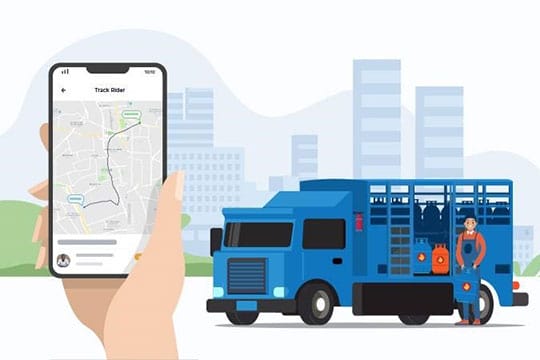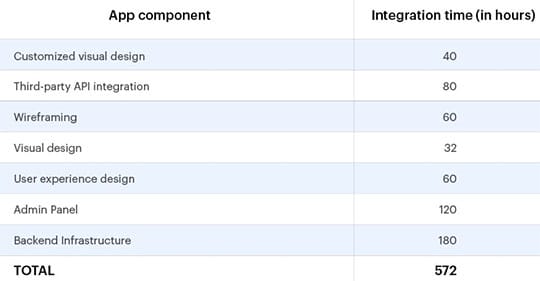The popularity of on-demand apps continues to grow over the years surpassing multiple business models. CNET reports that consumers across the world spend about £57.6 billion annually on various on-demand applications. Many industries are already utilizing and benefitting from the apps.
However, there are some industries that have not yet fully capitalized on the idea. An example of this is companies that supply cooking gas. There is a huge potential for these apps and entrepreneurs should consider developing on-demand apps for this type of business. Below we will talk about gas delivery app development considering the features that the apps should have and the cost implications.
How On-Demand Apps Work

On-demand delivery solution mostly works by acting as a mediator between businesses and clients. The platforms allow clients to order different types of products and services and have them delivered in minutes. The concept of on-demand apps is quite simple. Briefly check out how the apps work below:
- Customers place their request(s).
- The app connects a user to a service provider.
- The provider checks out the request before accepting it.
- Payment is authorized.
- The provider delivers the service or product.
- The client confirms the delivery.
- The app deducts payment.
Recommended for you: Two Types of On-Demand Food Delivery Platforms – Pros and Cons.
Factors to Consider When Developing On-Demand Gas Delivery Applications

LPG (Liquefied Petroleum Gas, wiki) is one of the most commonly used cooking fuels as it is considered cheaper and more convenient. If you would like to explore the business of developing an on-demand app that can help in the distribution of cooking gas, there are some factors you need to put into consideration before developing the app and these include:
Intensive Market Research

Before you start working on the app, it is important to conduct in-depth market research. Study some of the apps that are already in the market to know the strategies that the competition is using. You can also carry out focus groups to find out what customers are looking for. With this, you can get valuable insights that can help you create a great app that will be successful in the market.
Focus on User-Friendliness

When you want to build a cooking gas delivery app, you should focus more on coming up with a user-friendly app. No one wants to deal with a complicated app with confusing features. Developers must come up with a non-technical app that is simple for everyone to use.
Testing the App

Before launching an on-demand cooking gas app, it is always advisable to test the app before its official release date. This ensures you launch a reliable app that works flawlessly. Missing this step can put you into trouble. Clients can be put off by a non-functioning app and choose never to use it again even after you have rectified the initial mistakes.
Use the Latest Technology

You do not want to develop an outdated app. Do thorough research to know the latest technologies that are ideal for app development. Do away with old techniques and strategies that will be of no good for the on-demand app.
Key Features of On-Demand Gas Delivery Apps

The main aim of on-demand gas delivery apps is to offer a convenient platform where cooking gas suppliers can connect with their customers easily. There are some primary features the apps must have and some of them include:
Lucid Description:

Most people before downloading an app will keenly read its description to determine whether it is worth their time or not. Ensure you present an app with a clear and appealing description that will entice as many people as possible to download the app after they finish reading. The description needs to be short and sweet offering all the important details of the app.
Instant Ordering:

This allows clients to order new cylinders, re-fill existing ones, or exchange their cylinders instantly.
- Viewing Vendors who are nearby: The app should allow users to view all the vendors that are close to them sorted by distance.
- Choose Size and Brand: Customers should be able to choose the brand and size of the cooking gas cylinder they need with ease.
- Multiple Payment Options: The app should offer clients a wide range of payment options so that a person can choose the one that is most convenient for them. Note that all payment options should be secure.
- Track Drivers: The app should allow both vendors and clients to track drivers in real-time when delivering orders.
- Ratings and Reviews: Customers need to have a section on the app where they can rate their experiences using the application.
- Gas Leakage Detector: This is an important feature that promotes safety for users. Placing the detectors on gas cylinders helps to detect if they are any leakages. In case of a leakage, the customer will get an instant alert on their phone. This is a feature that can help save lives.
- 24/7 Support: One of the features that can make the apps attractive is including round the clock support. This way, users can reach out to a dedicated customer support team each time they have a question or concern.
- Analysis Performance: The design of the app should allow business owners to analyze its overall performance checking out all the statistics and metrics. Great apps also avail smooth inventory and transaction management. This makes operations error-free and quick.
You may like: Web Apps vs. Cloud Apps: Find the Ultimate Winner.
Choosing a Developer

If you do not have experience developing on-demand apps, you probably have to outsource to professionals who can do the job right. The cost of developing an on-demand cooking gas delivery app will mostly depend on the expert you choose. Some of the options you can choose from include:
Hiring an in-house developer team:

This is an ideal option if you are looking for a professional team that will handle long-term projects that require support round the clock. Getting an in-house team is usually quite costly because you have to cover costs like salaries, insurance, taxes, sick days, and vacation, etc.
Off-Shore Developers:

There is also an option of hiring offshore developers. Here you can choose to get one from an established company or go for a freelancer. A freelancer may be cheaper depending on the professional you decide to work with. Take time to and compare different options so that you can choose the one that will work best for your app’s vision.
Regardless of the option you choose, ensure that you find an experienced professional who is passionate about their job. This way, you will end up with an incredible app that you can use to expand your business without too many complications.
How Much It Costs to Develop an On-Demand Gas Delivery App

There are multiple factors that affect the cost of developing a cooking gas delivery app and these include:
Hours Spent on Development

The number of hours that developers spend building an app will determine how much it will cost. You can get an estimate from the developer to determine the amount of investment you will make.
Platforms

Picking the proper platform for the app is an essential process when you want to develop an on-demand cooking gas delivery app. Some of the factors to consider in regards to this includes app fragmentation, market share, prevalence, and size amongst others. The cost of the app will also be affected by multiple SDKs and various programming languages. You also need to choose whether the app is only going to work on a single platform or whether it will be a cross-platform application.
Functionality

The functionality of the app also plays a major role when it comes to development costs. An app with more complex features will cost more than one with fewer simpler ones.
Backend Infrastructure

Backend is the structure that developers use to provide data exchange between databases and the application. The analytics from this helps app owners to track the user’s activities. The cost of the backend structure will depend on the parameters that you are going to track.
Keep in mind that once the app is up and running, the work is not yet done. You must put in the effort to properly maintain the app so that it can run for a long period successfully. Keep studying the market to know the necessary tweaks that will be done so that the app remains timely to all its users. The screenshot below from Gasswift shows how much time it may take to develop an average on-demand cooking gas application.

The cost of developing the app can range from £15 to £ 255 an hour depending on the factors discussed above.
You may also like: How to Test, Evaluate, and Improve the Quality of Your Mobile Application?
Closing Thoughts

On-demand cooking gas delivery app solutions are bound to be in high demand in the coming years. App developers have to come up with ways of creating helpful apps with smart features that both consumers and businesses will take advantage of without any problem.
This article is written by Kunal Gohil. He is the Product Manager of Gasswift, one of the leading on-demand fuel delivery solutions. He is a highly motivated entrepreneur who drives his organization with his exemplary leadership skills. His aim is always to strive for perfection and to come up with innovative gas and fuel delivery solutions.
 This article is written by Kunal Gohil. He is the Product Manager of Gasswift, one of the leading on-demand fuel delivery solutions. He is a highly motivated entrepreneur who drives his organization with his exemplary leadership skills. His aim is always to strive for perfection and to come up with innovative gas and fuel delivery solutions.
This article is written by Kunal Gohil. He is the Product Manager of Gasswift, one of the leading on-demand fuel delivery solutions. He is a highly motivated entrepreneur who drives his organization with his exemplary leadership skills. His aim is always to strive for perfection and to come up with innovative gas and fuel delivery solutions.




